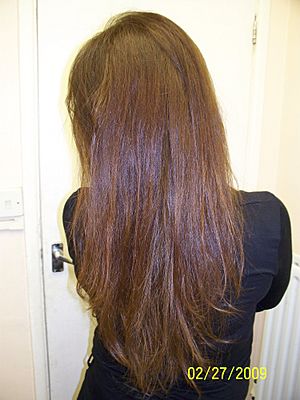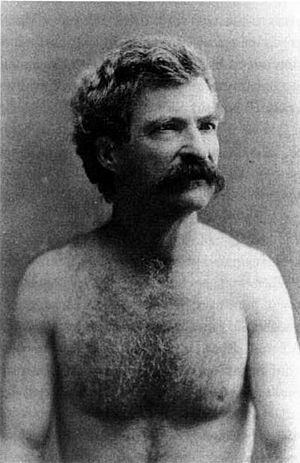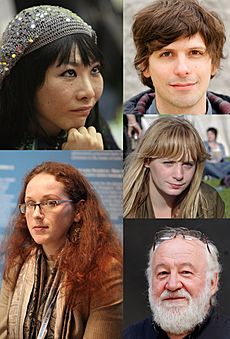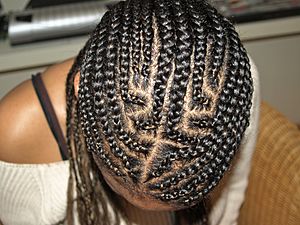Hair facts for kids
Hair is a special part of your body that grows from your skin. It's made of strong stuff called keratin, which is a type of protein. Many mammals, like dogs and cats, have hair all over their bodies, which we usually call fur. Animals like sheep and goats have curly hair called wool.
Humans and some other animals, like elephants and whales, have lost most of their hair over a very long time through evolution.
Contents
How Hair Helps Us and Animals
Hair does many important jobs for mammals. It helps keep them warm, hides them from danger, and even sends signals to other animals. Hair can also protect animals and helps them feel things around them.
Keeping Warm
For humans, the hair on our heads helps keep us warm and protects us from the sun. When we sweat, our hair can also help us cool down. Even though we wear clothes, the hair on our bodies helps control our temperature.
When you get cold, tiny muscles attached to your hair follicles (where hair grows from) pull your hairs up. This makes a layer of air close to your skin, which helps keep you warm. This is what we call "goose bumps"! It works even better for animals with thick fur, as their fur fluffs up to trap more air. When you're too warm, these muscles relax, and your hair lies flat, letting heat escape.
Protection from Danger
Some animals have special hair for protection. For example, hedgehogs and porcupines have hairs that have turned into sharp spines or quills. These hard, spiky hairs protect them from animals that might try to hurt them. Thick fur, like a lion's mane or a grizzly bear's coat, can also offer some protection from bites and scratches.
Feeling the World Around You
Hair also helps us feel things. Tiny nerves around each hair can sense when air moves or when something touches your hair. This helps you know if something is on your skin, like a tiny bug. Some hairs, like your eyelashes, are extra sensitive to keep you safe.
Eyebrows and Eyelashes
Your eyebrows help protect your eyes from dirt, sweat, and rain. They also help you show how you're feeling, like when you're surprised or angry.
Your eyelashes grow along the edges of your eyelids. They act like tiny sensors, similar to a cat's whiskers. If dust or anything else gets too close to your eye, your eyelashes sense it, and your eye closes very quickly to protect itself.
Not All Hair Is True Hair
Some animals, like certain insects and spiders, have what looks like hair. But these aren't true hairs in the same way mammals have them. They are actually called bristles. Even some plants have "hairs," but these are called trichomes.
Human Hair
Humans have hair mostly on their head, but also on other parts of their body. The amount of body hair can be different depending on a person's background. For example, people of Asian and Native North American descent often have less body hair, while Caucasians tend to have more.
Hair Color
Your natural hair color comes from your parents through your genes. You get your hair color from a mix of genes from both your mother and father. Some genes are "dominant" (they show up easily), and some are "recessive" (they might be hidden). This is why two parents with brown hair can sometimes have a child with blond hair!
Hair color comes from two types of natural colors called melanin: eumelanin and pheomelanin.
- Pheomelanin makes hair red.
- Eumelanin makes hair darker. A little bit of brown eumelanin makes hair blond, while more makes it brown. A lot of black eumelanin makes hair black, but a small amount can make hair gray. Everyone has some pheomelanin in their hair.
Many people choose to dye their hair to change its color. This uses chemicals to change the hair's natural color. People often dye their hair to cover up gray or white hairs that appear as they get older.
Hair Texture
The way your hair feels, how thick it is, and if it's straight, wavy, or curly, are all things you get from your genes. There are also differences between men and women; for example, men usually have thicker body hair than women.
Hair Loss
Most people have about 100,000 hairs on their head. It's normal for about 100 hairs to fall out each day, but new ones usually grow back. Sometimes, people lose more hair than grows back. This is called baldness.
Men often start to lose some hair as they get older, especially from the front and top of their heads. This is known as "male pattern baldness". While it's less common for women to go completely bald, many women's hair can become thinner on top as they age.
People have tried for thousands of years to find ways to stop hair loss or make hair grow back.
History and Culture
For a very long time, people have cared a lot about the hair on their heads. Styling and coloring hair has always been a way for both men and women to look good and get noticed. Sometimes, cultures and religions have special rules about hair. For example, in Sikhism, people are not allowed to cut their hair or beards.
Images for kids
-
Hair follicle of a cat.
-
Orange American shorthair cat.
-
Man with curly hair (David Luiz)
-
Portrait of a Woman by Alessandro Allori (1535–1607) at Uffizi Gallery. It shows a plucked hairline that was fashionable.
See also
 In Spanish: Pelo para niños
In Spanish: Pelo para niños




















